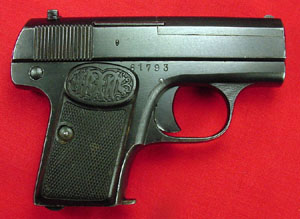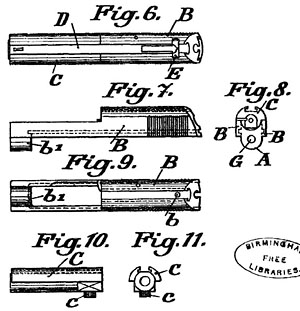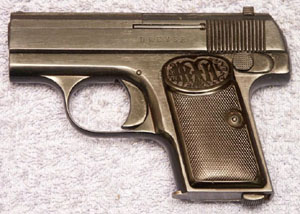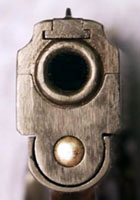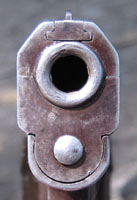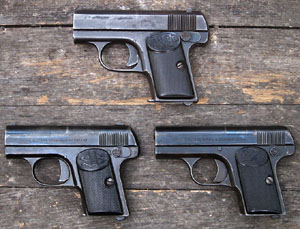 |
||||||||||||||||||||||||||||||||||||||||||||||||||||||||||||||||||||||||||||||||||||||||||||||||||||||||||||||||||||||
|
The Dreyse 6.35mm
Accurate information about Louis Schmeisser is difficult to come by, but F.W.A. Hobart states that he became the chief designer for RM&M in 1902, which would be about right, since his last pistol for Bergmann (the Bergmann Mars) was designed in 1901. By 1906 Schmeisser had designed the 7.65mm Dreyse pistol for RM&M, by 1908 he had designed the 6.35mm Dreyse Vest Pocket pistol, and by 1909 or 1910 he had designed the 9mm Parabellum Dreyse pistol.
Production of the Dreyse Vest Pocket may have begun late in 1909, after the German patent was filed. Hogg states that it was “[i]ntroduced shortly after the 7.65mm gun...,” but doesn’t give a specific date. Matthews states that the Dreyse 6.35mm pistol was designed in 1908 but “...probably was not offered commercially until 1909 (or possibly 1910), as the patent situation was not cleared up until 1910.” Both guns appear in the ALFA catalogue of 1911, which must have been in preparation as early as 1910. The Deutsche Waffenfabrik Georg Knaak catalogue of 1910 does not picture the Dreyse Vest Pocket, but does list a seven-shot 6.35mm Dreyse. It may be that the gun was so new when the catalogue was in preparation that no image of it was available . Production ended with the end of World War I, though guns continued to be sold from stock until well after the war. A correspondent from Germany sent me a copy of a receipt from RM&M for the sale of a Dreyse Vest Pocket pistol. It was for serial number 7485 and was dated 4 March 1915. This would tend to indicate that very few of these pistols were produced in the first few years of production. I would very much like to collect more date information like this--if you have an old receipt or other relevant information, please contact me.
The Dreyse Vest Pocket has a removeable backstrap to which are pinned the flat mainspring, sear, magazine release with its spring, and the flat spring that retains the safety lever on the right side. The entire assembly is held in the frame by a small pin at the bottom and the safety lever at the top. The trigger pivots on a pin through the frame to operate an internal transfer bar on the left side of the frame, which angles up toward the sear. A projection on top of the transfer bar serves as a disconnector, moving the transfer bar down and out of contact with the sear when the
The gun is marked DREYSE on the left side of the slide in all capital serif characters. At least one instance is known of a gun with no company markings (if you have one, I would appreciate hearing from you). The serial number is stamped on the right side of the frame just above the trigger pin. The serial number is also stamped in full on the inside of the slide, the bottom of the barrel, and the bottom of the locking bar. The first digit of the serial number on the frame of some specimens is partially obscured by the right-side grip panel. The barrel, slide, and frame are stamped with the German crown over N proof for nitro (smokeless) powder. The grips are of checkered black hard rubber with an RM&F monogram in an oval cartouche at the top. There are two main types of the Dreyse Vest Pocket. The Type I
The highest serial number we have observed for a Type I with dual extractors is 2160 but, interestingly, the lowest serial number we have recorded for a single extractor Type II is 2084, so it seems there was some crossover in serial number ranges for the two types. Matthews says: “Just when the change [from Type I to Type II] was made is not known, but the factory file of 1912 shows the single extractor type whereas advertisements of 1911 show the double type. From this it would appear that the change was made late in 1911 or early in 1912.” A number of early guns have been observed with two different serial numbers, and in every case only the first number is different. For instance:
With this many examples, there are almost certainly more, but they are impossible to identify unless they are disassembled. If you have an early serial number, please write to me. The Type II
The IIA variant retains the scallops on the top of the slide and barrel. It is like the Type I but with a single extractor. The lowest serial number observed for this variant is 2328 and the highest is 3652. If you have an example of this variant, please write to me, as I would like to make a better estimate of how many were made. The IIA may be the most scarce variant, but we do not know for certain. It may have been made simply to use up left-over parts from the Type I. The IIB variant eliminates the scallops and has the edges of the barrel and slide chamfered at approximately a 55° angle from the horizontal. The single extractor is moved up from the flat side to the angled portion of the chamfer on the breech block, and is pinned at an angle from the side of the breech block up through the corner of the slot for the locking bar. This is the most common variant of the Dreyse Vest Pocket pistol. The lowest serial number we have recorded for this variant is 2328 and the highest is 74608. From these numbers we can estimate that nearly 95% of all Dreyse Vest Pocket pistols are of the Type IIB variety. There is another minor variant which we don’t know enough about. My gun, serial number 24188, has a spring-loaded lever near the top of its magazine well. This is a magazine safety which was designed to lock the sear--however, it is inoperative on my gun. According to a letter I received from J.B. Wood, “...Herr Schmeisser designed the engagement with the sear to be very precise and small, and it is often found to be non-working.” Wood says the magazine safety on his Dreyse doesn’t work either. I believe that the Dreyse Vest Pocket probably came with the magazine safety from the earliest production pistols, and was discontinued due to the fact that it wore out prematurely; however, I have not been able to examine any early guns in person to verify this. Please contact me if you have a gun with this feature. I would like to try to establish just how many were made and when they were discontinued. I do know that the magazine safety lever was discontinued by serial number 51932. If you have an earlier gun without the magazine safety, please contact me.
Field Stripping the Dreyse Vest Pocket
Further Developments There are two guns that are direct descendants of the Dreyse Vest Pocket. One is the first model Haenel-Schmeisser designed by Hugo and Hans Schmeisser (Louis’ sons). The other is the Zehna Pistol designed by Emil Zehner. The Model I Haenel-Schmeisser is externally quite close to the Dreyse Vest Pocket, but internally is quite different--the removeable backstrap has been eliminated and the gun features coil springs and a magazine safety in addition to a patented takedown mechanism. The Zehna is almost identical to the Dreyse Vest Pocket, differing only in the takedown method, the length of the barrel, and the external conformation of the slide.
|
||||||||||||||||||||||||||||||||||||||||||||||||||||||||||||||||||||||||||||||||||||||||||||||||||||||||||||||||||||||
|
Copyright 2011 by Ed Buffaloe. All rights reserved. |
||||||||||||||||||||||||||||||||||||||||||||||||||||||||||||||||||||||||||||||||||||||||||||||||||||||||||||||||||||||
|
|
||||||||||||||||||||||||||||||||||||||||||||||||||||||||||||||||||||||||||||||||||||||||||||||||||||||||||||||||||||||
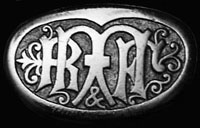 After 1901 the Dreyse company was owned by the Rheinische
Metallwaaren & Maschinenfabrik company (RM&M, later known as Rheinmetall), located in the town of Sömmerda in Thuringia, Germany. RM&M used the Dreyse name for their small arms.
After 1901 the Dreyse company was owned by the Rheinische
Metallwaaren & Maschinenfabrik company (RM&M, later known as Rheinmetall), located in the town of Sömmerda in Thuringia, Germany. RM&M used the Dreyse name for their small arms.